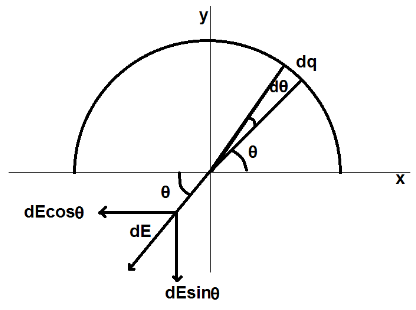Question
Question: A thin half ring of radius \[R = 20cm\] is uniformly charged with a total charge \[q = 0.70nC\]. The...
A thin half ring of radius R=20cm is uniformly charged with a total charge q=0.70nC. The magnitude of electric field strength at the curvature centre of this half ring is:
A. 100V/m
B. 20V/m
C. 225V/m
D. 4V/m
Solution
In this problem, to find the magnitude of electric field strength at the curvature centre of the half ring, we will consider this ring consists of a large number of very small arcs. Then we will consider one such small segment and then integrate its horizontal and vertical components of electric field strength to determine the required magnitude of electric field strength at the curvature centre.
Formula used:
E=R2kq,
where E is the electric field strength, k is the constant with a value 8.99×109Nm2/s, q is the total charge and distance of the point from the charged surface.
Complete step by step answer:
Let us first consider a very small arc element. Let it be lying at an angle θ with respect to the x-axis and subtending a small angle dθat the centre of the curvature of the half ring as shown in figure.

Let the charge on the small element be dq=πqdθ which can be assumed to be a point charge. Now, the small electric field produced by this small arc element carrying dq charge is given by
dE=R2k(dq) ⇒dE=R2k(πqdθ) ⇒dE=πR2kqdθ
Now, we will find the horizontal and vertical component of the total electric field strength by integrating this small electric field.
First, the horizontal component is given by
Ex=θ=0∫θ=πdEcosθ ⇒Ex=0∫ππR2kqcosθdθ ⇒Ex=0
As the horizontal component is zero, the total electric field is same as its vertical component which is given by
E=Ey ⇒E=θ=0∫θ=πdEsinθ ⇒E=0∫ππR2kqsinθdθ
